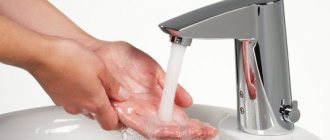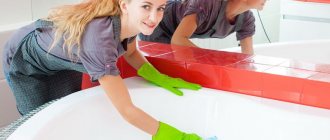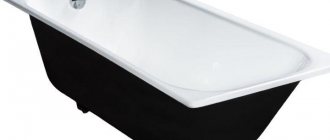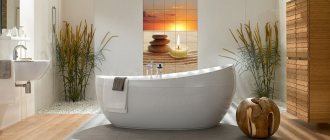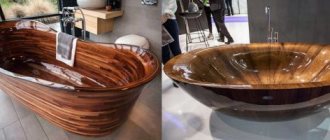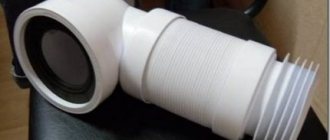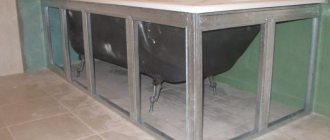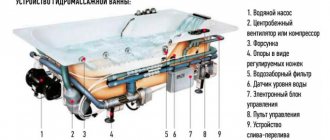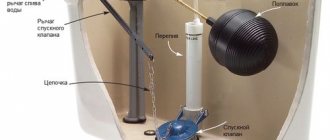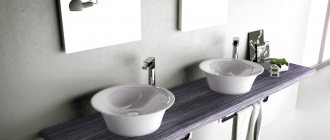During a complete renovation of an apartment or your own home, you often have to change ordinary plumbing fixtures that have already served their purpose, having lost their attractiveness, and sometimes functionality. Of course, first you have to lay new tiles on the floor and walls, completely or partially change the water supply and sewer pipes, but after all this work is done, it comes to installing a shower cabin, toilet bowl and replacing the old bathtub.
It should be noted that even with the current popularity of acrylic plumbing fixtures, cast iron bathtubs have not lost their popularity and are in fairly high demand due to a number of undoubted advantages. Despite the fact that installing a cast iron bathtub is a fairly simple process, the weight and dimensions of this huge vessel require compliance with certain installation rules that will help avoid accidental damage to tiles and other finishing materials. Some nuances of performing such work can be seen in the video presented for the lesson.
Types of baths
Bathtubs are manufactured in a wide variety of assortments, differing in size, shape, bottom configuration, coating color and other parameters. But for the manufacturer, the main difference factor, which has the greatest impact on the costs and complexity of organizing the technological process, is the material of manufacture. Various raw materials are used to produce bathtubs, including even stone, glass and wood. But the most common and in demand are products made of cast iron, steel and acrylic. The rest of the materials are used to create designer models, mainly for individual orders.
Cast iron
Cast iron bathtubs appeared earlier than all other options under consideration and still hold one of the leading positions in the plumbing market.
babylass/Pixabay
Their main advantages are such important characteristics as:
- strength, durability;
- good stability due to massiveness;
- excellent noise absorption;
- resistance to mechanical damage;
- ease of care.
A relative advantage of cast iron bathtubs is their low thermal conductivity. The water in them retains its temperature for quite a long time, but the heat capacity of acrylic products is 2 times higher. At the same time, cast iron takes much longer to heat up.
Other disadvantages of this material include:
- monotony of design - only classic bathtubs can be cast from cast iron;
- the complexity of the restoration - chips and cracks can only be repaired by specialists.
The large weight, which makes the cast iron bathtub as stable as possible, significantly complicates its transportation and installation. The walls of a quality product must have a thickness of at least 0.5 cm, which, taking into account the heaviness of cast iron, provides the bath with a mass of 90 to 150 kg, depending on the size.
Steel
Steel baths have a lower cost due to fully automated production. At the same time, high-quality products have a long service life (about 30 years) and many other advantages.
The advantages of a steel bath include:
- variety of design - due to the manufacturing method of stamping and the plasticity of steel sheets, the shapes and sizes of products can be very different;
- light weight (15–50 kg), ensuring easy transportation and installation;
- high hygiene - thanks to the enamel coating baked at high temperatures, on which microcracks do not form, the surface remains clean even with minimal care;
- possibility of installing additional devices - jacuzzi, handles, headrests, anti-slip bottom.
The disadvantages of steel bathtubs are significant, but easily eliminated with proper installation:
- high thermal conductivity - steel does not retain heat well, so it is recommended to place it in a thermal insulation casing;
- poor stability - also corrected by the above method;
- slight deformation under the influence of gravity - to prevent the bottom from sagging, it is necessary to lay a special base;
- rapid oxidation on chips - in order to avoid rust, all damage requires urgent repair.
The quality of a steel bath is influenced by two parameters - wall thickness (at least 2.5 mm) and the absence of defects in the enamel coating. Thin walls easily bend and deform, and local thinning or thickening of the enamel layer, roughness, and foreign inclusions significantly reduce the service life of the product. The “correct” coating should be smooth and uniform.
Acrylic
Bathtubs made of acrylic appeared relatively recently, but their production is considered the most promising. The main characteristics, advantages and disadvantages of the finished product directly depend on the material used.
Acrylic bathtubs are made from two types of acrylic fabric:
- cast acrylic by pressing at high temperatures, followed by reinforcement with fiberglass or polyurethane;
- cheap ABC plastic with a thin acrylic coating that does not provide adequate strength to the product.
Cast acrylic bathtubs offer many benefits, including:
- the presence of an absolutely homogeneous surface without microcracks, which ensures increased hygiene of the product;
- ease of cleaning from any contaminants;
- resistance to cracking and high loads;
- the ability to independently repair minor damage using regular grinding or processing with special pastes.
Such products have a relatively high cost, but are also used for at least 15 years.
The “sandwich” bathtub is characterized by low strength and can crack from any mechanical impact, and also easily bends under the weight of a person. The slightest damage to the top acrylic layer leads to the destruction of non-moisture resistant plastic and the entire product as a whole. For all these reasons, the service life of such baths is no more than 4 years, but their cost is also several times lower. These products are in demand among those buyers who often prefer to change the interior design of their bathroom or want to install temporary plumbing fixtures.
How to choose the right cast iron product?
Factory enamel is applied in powder form and melted at a temperature
The service life of cast iron products largely depends on the quality of the enamel layer.
Note: If the manufacturer wants to save on coating, zirconium salt is added to the enamel. Due to this impurity, the coating of plumbing fixtures quickly undergoes corrosion and mechanical damage. As a rule, the enamel layer on imported products is of much better quality.
In any case, durable enamel is formed as a result of applying a special powder to the surface of cast iron, which, under serious influence of temperature (about 1200 degrees), turns into an impeccably smooth “glaze”.
When choosing plumbing fixtures, special attention should be paid to components, in particular, legs. If their strength does not inspire confidence, you should abandon this option. The legs must be strong and stable, and also fit perfectly in the fastening points; if gaps are found, it is better not to take plumbing fixtures.
If a consultant claims that the plumbing fixtures are manufactured according to state standards, do not hesitate to ask him for documents confirming the truth of the words. Still, the issue of choosing a new bathtub is a serious one, so you should make every effort to make the right decision. Only in this case will the purchased product please you for many years.
Bath production equipment
In the production of bathtubs from cast iron, casting is used, from steel - stamping, from acrylic - vacuum forming. For each specified technology, a corresponding set of equipment is required.
For cast iron production you will need:
- melting furnace;
- molds for filling;
- cooling chamber;
- degreasing chamber;
- drying chamber;
- spray gun;
- firing line;
- packaging line.
The line for the production of bathtubs from steel sheets includes:
- conveyor;
- Hydraulic Press;
- cutting device;
- bending apparatus;
- welding machine;
- conveyor;
- degreasing chamber;
- drying chamber;
- spray gun;
- firing line;
- packaging line.
To produce bathtubs from acrylic, you only need a vacuum forming machine, molds of the required configuration and an installation for spraying a reinforcing composition.
Video of such a machine in operation:
Prices start at approximately $30,000.
It should be noted that another type of equipment is used for spraying - an installation for spraying resin and chopped glass roving. This installation does the following:
- prepares the binder (evenly mixes the resin and hardener in a given proportion),
- grabs a glass thread and chops it into short pieces (chops),
- adds chops to the binder and sprays this mixture onto the matrix.
Introductory video from MVP, the largest manufacturer:
Modern vacuum forming equipment allows you to create different shapes of acrylic bathtubs and decorative screens of any complexity. In addition to bathtubs, most elements of shower cabins are produced using such vacuum forming equipment, right down to transparent shower doors made of polyethylene terephthalate. The main feature of this vacuum forming equipment is the possibility of positive, negative and combined molding. And due to the presence of double-sided heating of the workpiece, the productivity of the equipment significantly increases.
An example of work carried out by specialists: video clip
The enameled surface of a cast iron bathtub can be restored at home. The procedure will take about three hours and require a week for the composition to completely dry. After this time, the bowl of sanitary equipment will delight the eye with a smooth snow-white surface.
It is clear that the new enamel will be somewhat different from the one that was applied to the bowl at the factory. However, if the rules for its application and operation are strictly followed, it will last about 10 years, after which it can be renewed.
Thus, the owner will be able to save a significant amount that would have to be spent on the purchase and installation of new equipment, and avoid repairs that are inevitable when dismantling an old cast-iron bathtub.
Raw materials
For each type of bath, the appropriate raw materials are used:
- for cast iron - a circle or other cast iron castings;
- for steel – cold-rolled steel sheets 1.5–3.5 mm thick in rolls;
- for acrylic - sheets of technical acrylic (methacrylic) and reinforcing materials (resin and glass roving).
In addition to the main raw materials, additional materials will be required - enamel for the primer and main coating, fittings and other components as necessary. When choosing suppliers, it is necessary to take into account that the quality of metal or acrylic, as well as enamel for coating, directly affects the consumer characteristics of the bathtub. Therefore, preference should be given to trusted companies offering certified materials.
Restoring with two-component enamel
Restoring a bathtub using enamel is an inexpensive and uncomplicated method. It should be borne in mind that the compositions for preparing enamel are quite caustic and have an unpleasant odor, so you should use a respirator.
Also be sure to wear rubber gloves. Mix the enamel and hardener according to the instructions. The finished composition has a consistency like paint, so it will not be difficult to work. Cover the entire surface with the prepared mixture using a brush. First, go through horizontal strokes, then vertical ones. When you have finished applying the first coat, pause for 10-15 minutes and begin to coat the tub a second time without waiting for the previous coat to dry completely. Pay special attention to processing the bottom - it is in this area that the coating experiences the greatest load.
A sprayer makes the process of applying enamel easier. If you have such a device, then use it, but also be careful and make sure that there are no areas not covered with enamel.
After the coating is completely completed, you need to leave the bath for 5-7 days until the enamel completely hardens. During this time, it is advisable to ensure that the bathroom is clean and avoid contact with any solid particles, drops of water or other liquids on the surface. If these conditions are met, you will receive a new smooth bowl, with rich color and soft shine. A bathtub restored with two-component enamel will serve you for several years.
Bath production technology
Technologically, the production of bathtubs from sheets of steel and acrylic does not have significant differences, since in both cases the sheet material is given the required shape, but using different methods. To produce cast iron products, a more labor-intensive casting method is used.
Made of cast iron
The manufacturing technology of cast iron bathtubs has not changed since their appearance and, as before, consists of the following stages:
- cast iron melts;
- poured into the mold;
- cools, removes from mold;
- the surface of the product is cleaned.
The finishing process should result in a perfectly smooth surface, since the slightest defects will negatively affect the quality of the applied enamel coating.
Next, the prepared “semi-finished product” is covered with enamel. The service life and hygienic characteristics of the bathtub depend on the uniformity, thickness and strength of this layer. On a poor-quality coating, microcracks quickly appear, into which dirt, germs and moisture penetrate. As a result, the product loses its attractiveness, is difficult to clean and quickly rusts in areas of damage.
Of steel
The production process of steel baths is fully automated. The operator only controls the execution of operations and the quality of finished products.
The technology includes the following stages:
- a piece is cut from a roll of sheet steel, the dimensions of which are determined by the dimensions and shape of the future product;
- the workpiece is fed through a conveyor into a hydraulic press, where it is stamped under high pressure to give a given configuration;
- then excess parts are cut off from it, the sides are tucked in and holes are made for draining and overflowing water;
- At the end of the machining, the mounting brackets are welded;
- Then the bath is degreased (the grease is washed off), dried, checked and, if there are defects, rejected.
After this, the products that have passed the inspection are covered with enamel. The entire bathtub is first primed, and then a second coating layer of enamel is applied to its inner surface. These operations are performed using robotic paint sprayers, ensuring high uniformity and smoothness of the coating.
The painted product is dried and fed to the firing line. Firing is carried out in a kiln at a temperature of 900° Ϲ. This gives the enamel a glossy shine and significantly increases its strength characteristics.
To reduce the noise and thermal conductivity of steel baths, some manufacturers perform additional processing. For this purpose, a polyurethane foam board is glued to the bottom or a polymer coating is applied over the entire outer surface.
The finished bath is fed to the packaging line, where it is placed in a cardboard casing and equipped with an installation kit. The casing is marked with information about the manufacturer.
Made from acrylic
The whole process is carried out according to this scheme:
- the sheet is placed on the frame and heated;
- a mold is placed under it, along the contours of which the product is formed under vacuum pressure;
- the resulting bathtub is removed from the mold, trimmed and cleaned around the perimeter.
The prepared product is fed into an installation for spraying a reinforcing composition, where the following operations are performed:
- the resin and hardener are mixed to obtain a binder;
- the glass thread is chopped into small pieces;
- All components are combined and sprayed onto the surface of the bath.
As the name suggests, acrylic, or rather sheets of it, is used as the main raw material for the production of acrylic bathtubs.
- Polymethacrylate (PMMA, white plexiglass) - has high resistance to abrasion.
- Acrylonetrile butadiene styrene-polymethyl methacrylate (ABS-PMMA, a mixture of ABS and PMMA) is a two-layer material: the bottom layer is acrylic-nitrile butadiene styrene rubber and the top layer is polymethyl methacrylate acrylic. The sheets are produced using the co-extrusion method. Acrylic bathtubs made from it have low abrasion resistance and a short service life. The price is 1.5-2 times cheaper than pure PMMA.
There is also another type of these polymer materials - QUARYL - a modern composite material that contains acrylic, quartz and environmentally friendly polymer additives. Patented by Villeroy & Boch and mainly used by them only in their baths and sanitary ware.
The service life of the bath depends on the thickness of the acrylic sheet used:
- 4-5 mm – an acrylic bathtub will last 10 years;
- 5-6.5 – an acrylic bathtub will last 12-15 years.
The production of technical acrylic is based on the use of special additives designed to reduce the ability to reproduce all kinds of harmful microorganisms and bacteria on the surface. This type of acrylic is used in the manufacture of bathtubs, which makes the finished product more hygienic and safe.
The production technology of acrylic bathtubs allows us to obtain products of the highest quality and reliability. In this method, an acrylic sheet is heated until it becomes pliable. When molten, the melt is placed in a special bath mold. This uses a vacuum extrusion process. To achieve sufficient strength, reliability and durability, several layers of fiberglass are applied. The specified parameters depend on the number of layers. In general, acrylic bathtubs produced by this method are endowed with improved quality characteristics. They are able to maintain their appearance and attractiveness throughout the entire period of operation, without creating any problems for the owners.
Video of how acrylic bathtubs are made using vacuum forming:
At each stage of production, all products undergo thorough quality control and compliance with technical regulations.
The body of the manufactured acrylic bathtub is necessarily reinforced with glass fiber and/or polyurethane. The latter material has a very low thermal conductivity coefficient and makes it possible to further increase the service life of such a bath. Polyurethane is endowed with excellent adhesive properties, which is why the material can be easily sprayed onto almost any surface, even the ceiling. One of the important properties of polyurethane is its environmental safety, therefore it can be used for the production of products used for food products.
The cheapest variety is acrylic bathtubs made from two-layer ABS/PMMA sheets. For their manufacture, sheets of polymethyl methacrylate with acrylonitrile butadiene styrene are used. Such bathtubs are called “acrylic” only conditionally. Hence the low durability of the product. This is explained by the fact that the inner layer of the bathtub is very thin and therefore very vulnerable to mechanical stress. The service life of the products in this case is 3-4 years, after which replacement is required.
Disadvantages of cast iron products
Cast iron bathtubs cannot please you with a variety of shapes
- Considerable weight. The large weight of the plumbing fixtures, in a sense, complicates the installation procedure, however, this criterion also speaks about the stability of the bathtub, which, for example, acrylic and metal products cannot boast of;
- Due to the peculiar properties of cast iron, this type of plumbing does not offer a variety of shapes. At the same time, this drawback can be easily compensated for by the creative design of the legs of the product, as well as decorative finishing on the outside.
Legal registration
To run a bathtub manufacturing business, you must register as an LLC. The application for the tax inspectorate indicates the OKVED codes corresponding to the area of activity:
- 22.23 – “Production of plastic products used in construction” (for acrylic bathtubs);
- 25.99.1 – “Production of metal products for bathrooms and kitchens” (for cast iron and steel bathtubs).
As a tax regime, you can choose the simplified tax system at a rate of 15% of profit.
Requirements for the quality of baths are regulated by the provisions of the following GOSTs:
- R 50962-96 “Dishes and household products made of plastic. General technical conditions";
- 18297-96 “Enameled cast iron sanitary appliances. Technical conditions";
- 23695-2016 “Sanitary and technical steel enameled appliances. Technical conditions";
- 9.104-79 “Unified system of protection against corrosion and aging (USZKS). Paint and varnish coatings. Groups of operating conditions";
- 380-2005 “Ordinary quality carbon steel. Stamps."
When organizing a technological process in a production workshop, it is necessary to comply with the standards established by the relevant acts:
- GOST:
- 12.1.005-88 “System of occupational safety standards. General sanitary and hygienic requirements for the air of the working area";
- 12.3.030-83 “System of occupational safety standards. Plastics processing. Safety requirements";
- 12.4.021-75 “System of occupational safety standards. Ventilation systems. General requirements";
- 12.1.004-91 “System of occupational safety standards. Fire safety. General requirements";
- 12.2.061-81 “System of occupational safety standards. Production equipment. General safety requirements for workplaces."
- Decree of the Government of the Russian Federation dated April 25, 2012 No. 390 “On the fire safety regime.”
- SanPiN:
- 2.2.4.548-96. 2.2.4. “Physical factors of the production environment. Hygienic requirements for the microclimate of industrial premises. Sanitary rules and regulations”;
- 2.1.7.1322-03 “Hygienic requirements for the disposal and disposal of production and consumption waste”;
- Sanitary standards SN 2.2.4/2.1.8.562-96 “Noise in workplaces, in residential and public buildings and in residential areas.”
The production of bathtubs from any material is not subject to licensing, mandatory certification or declaration. But obtaining a voluntary certificate confirming that products comply with the requirements of these norms and standards will become a significant competitive advantage.
Premises and staff
The bathtub production line consists of large-sized equipment that requires a minimum of 150 sq.m. for its location and maintenance. In addition, to organize the work of the enterprise, additional space is needed for other zones:
- administrative
- warehouse
- official
- utility room
In general, for a plant you need to look for a room measuring at least 200 square meters. m, located on the outskirts, in the suburbs or in an industrial area. A mandatory requirement for the internal arrangement of a production workshop is the presence of industrial ventilation and all utilities (heating, water supply, sewerage, 380 volt power supply).
For an enterprise with one production line and one shift operation, the following staffing will be required:
- director;
- technologist;
- accountant;
- supply manager;
- sales manager;
- line operators – 3;
- packers – 2;
- loaders – 2;
- cleaner.
When expanding the scale of production by installing additional lines and/or maintaining a two- or three-shift operating mode, the number of production personnel will increase in proportion to these changes.
Removing shallow scratches
The use of multi-component cleaning products, cleaning the contaminated surface with a stiff brush, careless handling of metal objects during repairs - all this leads to the formation of shallow scratches.
Such scratches must be eliminated immediately, since the penetration of moisture and caustic chemicals into the resulting gap leads to the formation of rust, the proliferation of moisture-loving microorganisms and an increase in the size of the scratch. Which will lead to further destruction of the bathtub surface.
Shallow scratches include damage that does not expose metal. These minor damages can be repaired even without priming the surface.
The factory enamel on the bowl of a cast iron bathtub is very durable, so a screwdriver is needed to remove shallow scratches. If it has already been restored with acrylic or epoxy enamel, sanding paper will be suitable for treating micro-scratches.
In addition, to treat microdamages you will need:
- fine-grained sandpaper marked P1200, P1500 or a screwdriver with an attachment for attaching an abrasive wheel;
- fine abrasive car polish - economical polishes for one-time use are pastes from WILLSON and RUNWAY;
- wax polish without abrasive , for example, Golden Wax.
At the first stage, it is necessary to wash the surface with Pemolux, Comet, Sorti or baking soda to degrease. After removing the product, you need to dry the bath.
Next, the surface is polished with fine-grained sandpaper or a screwdriver with an abrasive wheel - zero, until leveled. When processing a scratch with a screwdriver, the minimum speed is set.
The treatment area must be constantly damp to prevent cracks from appearing when heated. Therefore, during the entire stage of primary polishing, it is necessary to pour a thin stream of water onto the damage.
After the treated surface becomes smooth and matte, it is necessary to apply a grainy polish to it. Treatment with a low-abrasive composition is carried out vertically, then horizontally, until a smooth, uniform surface is obtained.
The final stage of eliminating minor scratches is finishing the coating with car polish and wax. Wax-containing polishes are water-repellent and add a sparkling shine to any surface.
The polishing cloth should be soft and lint-free. Therefore, it is better to use flannel, calico, felt or microfiber cloths
After obtaining a shiny surface, it must be washed with soapy water or a non-aggressive liquid cleaning agent: Tersi, Oda, Sarma. Immediately after this, the bath can be used.
Sales and advertising
The production of bathtubs has long been well developed in Russia. Most manufacturers have been working for a long time and fully satisfy the market needs. In addition, experience in this area can significantly reduce costs and reduce the cost of products. It will be difficult for a novice entrepreneur to beat such serious competitors. The only advantage may be the proximity to direct consumers. Therefore, it is necessary to study the market conditions in your own and neighboring regions and, if there are large factories nearby, think about the feasibility of opening a new enterprise.
The best option in this case is to manufacture exclusive products to order. The number of sales may be insignificant, but this direction will allow you to occupy your niche and beat major competitors. The disadvantage of large factories is the difficulty of changing the production process, while small production can be very flexible.
You can also offer buyers more favorable transaction terms:
- sell bathtubs at retail through your online store at the same price, but with free shipping;
- establish a long warranty period (this creates increased confidence in the product);
- at the initial stage, reduce the markup to a minimum so that the purchase price is not higher than that of competitors.
In addition, it is imperative to organize an advertising and marketing campaign, using all the possibilities of online advertising, outdoor and print advertising media.
